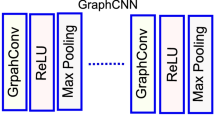Abstract
In this article, we explore the effectiveness of using neural networks to generate skeleton-based representations of shapes. Deep-learning approaches have proven very efficient to extract meaningful information from images. Our goal is to learn a mapping from a binary image of a 2D shape to a parametric Bézier curve representation of the medial axis of the shape using a convolutional neural network. We determine the most salient curves in the Blum medial axis and then train a CNN to produce one, two, and five curve medial representations. Using a Bézier curve representation of the medial axis reduces the number of parameters, since we express medial curves and their radii as degree-five Bézier curves, and learn only the associated control points rather than the full point set of the medial axis.
Access this chapter
Tax calculation will be finalised at checkout
Purchases are for personal use only
Similar content being viewed by others
Notes
- 1.
MPEG-7 dataset: http://www.dabi.temple.edu/$sim$shape/MPEG7/dataset.html.
References
Aujay, G., Hétroy, F., Lazarus, F., Depraz, C.: Harmonic skeleton for realistic character animation. In: Proceedings of the 2007 ACM SIGGRAPH/Eurographics symposium on Computer animation, pp. 151–160. Eurographics Association (2007)
Blanc-Beyne, T., Morin, G., Leonard, K., Hahmann, S., Carlier, A.: A salience measure for 3d shape decomposition and sub-parts classification. Graphical Models 99, 22–30 (2018)
Blum, H.: Biological shape and visual science. Journal of theoretical Biology 38(2) (1973)
Chollet, F., et al.: Keras (2015). https://github.com/fchollet/keras
Csáji, B.C.: Approximation with artificial neural networks. Ph.D. Thesis, Faculty of Sciences, Etvs Lornd University, Hungary 24, 48 (2001)
Durix, B., Chambon, S., Leonard, K., Mari, J.L., Morin, G.: The propagated skeleton: a robust detail-preserving approach. In: DGCI (2019)
Giblin, P.J., Kimia, B.B.: On the local form and transitions of symmetry sets, medial axes, and shocks. International Journal of Computer Vision 54(1–3), 143–157 (2003). https://doi.org/10.1023/A:1023761518825
He, K., Zhang, X., Ren, S., Sun, J.: Deep residual learning for image recognition. In: Proceedings of the IEEE conference on computer vision and pattern recognition, pp. 770–778 (2016)
Krizhevsky, A., Sutskever, I., Hinton, G.E.: Imagenet classification with deep convolutional neural networks. Commun. ACM 60(6), 84–90 (2017). https://doi.org/10.1145/3065386
Larsson, L., Morin, G., Begault, A., Chaine, R., Abiva, J., Hubert, E., Hurdal, M., Li, M., Paniagua, B., Tran, G., et al.: Identifying perceptually salient features on 2d shapes. In: Research in Shape Modeling, pp. 129–153. Springer (2015)
Latecki, L.J., Lakamper, R., Eckhardt, T.: Shape descriptors for non-rigid shapes with a single closed contour. In: IEEE Conference on Computer Vision and Pattern Recognition’00, pp. 424–429 (2000)
Leonard, K., Morin, G., Hahmann, S., Carlier, A.: A 2D shape structure for decomposition and part similarity (2016). https://hal.inria.fr/hal-01374810/documen.
Liu, X., Gopal, V., Kalagnanam, J.: A spatio-temporal modeling approach for weather radar reflectivity data and its applications in tropical southeast Asia (2016)
Mahendran, S., Ali, H., Vidal, R.: 3d pose regression using convolutional neural networks. In: 2017 IEEE International Conference on Computer Vision Workshops (ICCVW), pp. 2174–2182 (2017). https://doi.org/10.1109/ICCVW.2017.254
Matsugu, M., Mori, K., Mitari, Y., Kaneda, Y.: Subject independent facial expression recognition with robust face detection using a convolutional neural network. Neural Networks 16(5–6), 555–559 (2003)
Sundar, H., Silver, D., Gagvani, N., Dickinson, S.: Skeleton based shape matching and retrieval. In: SMI (2003). https://doi.org/10.1109/SMI.2003.1199609
Yushkevich, P., Fletcher, P.T., Joshi, S., Thall, A., Pizer, S.M.: Continuous medial representations for geometric object modeling in 2d and 3d. Image and Vision Computing 21(1), 17–27 (2003)
Author information
Authors and Affiliations
Corresponding author
Editor information
Editors and Affiliations
Rights and permissions
Copyright information
© 2021 The Authors and the Association for Women in Mathematics
About this chapter
Cite this chapter
Fondevilla, A., Morin, G., Leonard, K. (2021). Towards Learning Geometric Shape Parts. In: Demir, I., Lou, Y., Wang, X., Welker, K. (eds) Advances in Data Science. Association for Women in Mathematics Series, vol 26. Springer, Cham. https://doi.org/10.1007/978-3-030-79891-8_5
Download citation
DOI: https://doi.org/10.1007/978-3-030-79891-8_5
Published:
Publisher Name: Springer, Cham
Print ISBN: 978-3-030-79890-1
Online ISBN: 978-3-030-79891-8
eBook Packages: Mathematics and StatisticsMathematics and Statistics (R0)




